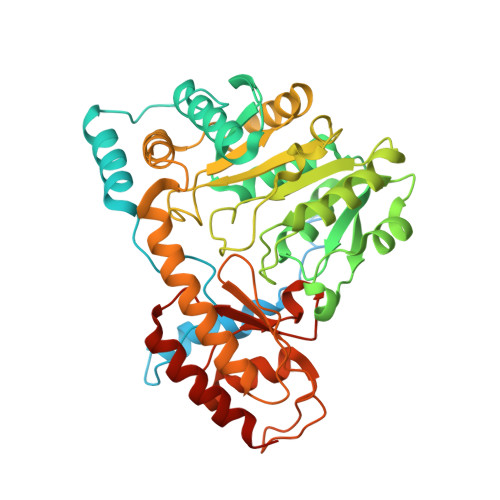Structural basis for substrate recognition and inhibition of prephenate aminotransferase from Arabidopsis.
Holland, C.K., Berkovich, D.A., Kohn, M.L., Maeda, H., Jez, J.M.(2018) Plant J 94: 304-314
- PubMed: 29405514
- DOI: https://doi.org/10.1111/tpj.13856
- Primary Citation of Related Structures:
5WMH, 5WMI, 5WMK, 5WML - PubMed Abstract:
Aromatic amino acids are protein building blocks and precursors to a number of plant natural products, such as the structural polymer lignin and a variety of medicinally relevant compounds. Plants make tyrosine and phenylalanine by a different pathway from many microbes; this pathway requires prephenate aminotransferase (PAT) as the key enzyme. Prephenate aminotransferase produces arogenate, the unique and immediate precursor for both tyrosine and phenylalanine in plants, and also has aspartate aminotransferase (AAT) activity. The molecular mechanisms governing the substrate specificity and activation or inhibition of PAT are currently unknown. Here we present the X-ray crystal structures of the wild-type and various mutants of PAT from Arabidopsis thaliana (AtPAT). Steady-state kinetic and ligand-binding analyses identified key residues, such as Glu108, that are involved in both keto acid and amino acid substrate specificities and probably contributed to the evolution of PAT activity among class Ib AAT enzymes. Structures of AtPAT mutants co-crystallized with either α-ketoglutarate or pyridoxamine 5'-phosphate and glutamate further define the molecular mechanisms underlying recognition of keto acid and amino acid substrates. Furthermore, cysteine was identified as an inhibitor of PAT from A. thaliana and Antirrhinum majus plants as well as the bacterium Chlorobium tepidum, uncovering a potential new effector of PAT.
- Department of Biology, Washington University in St Louis, St Louis, MO, 63130, USA.
Organizational Affiliation:

















